Joints powerpoint
Download as ppt, pdf144 likes72,436 views
Joints connect bones together and allow movement. There are over 200 joints in the human body. Joints are classified by their structure and movement. The three main types are fibrous, cartilaginous, and synovial joints. Synovial joints are the most common and movable. They include ball-and-socket, hinge, and gliding joints which allow different types of movement like flexion, extension, and rotation.
1 of 18
Downloaded 8,896 times


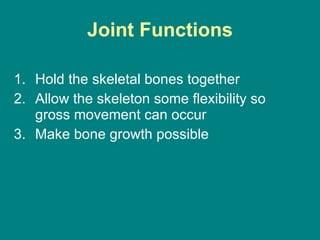
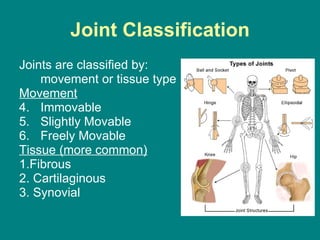

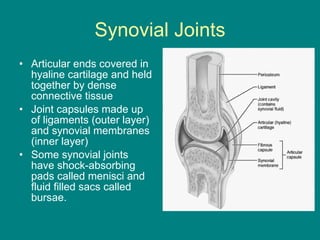
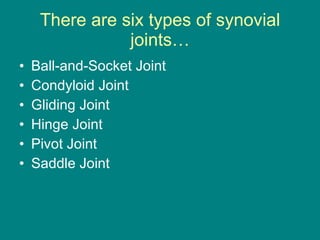
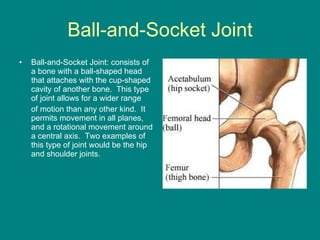
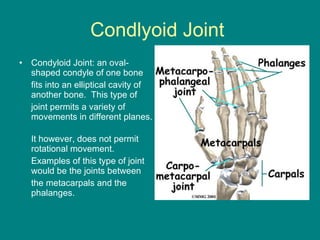

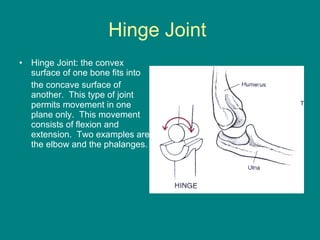


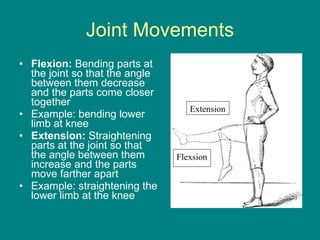

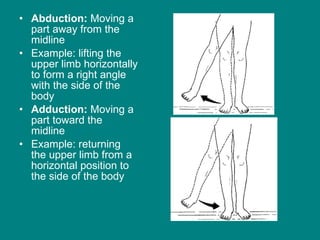
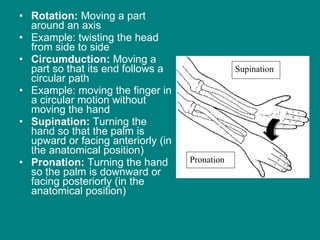

Ad
Recommended
Spinal cord
Spinal cordDr. Binu Babu Nursing Lectures Incredibly Easy
Ã˝
The spinal cord extends from the skull to the lumbar vertebrae and contains gray matter in an H-shaped arrangement. It provides bidirectional communication between the brain and body via ascending and descending tracts. The spinal cord is protected within vertebrae and surrounded by meninges including the dura, arachnoid, and pia mater.internet addiction
internet addictionAtiqul Haq Mazumder
Ã˝
Internet addiction is being considered as a diagnosis for inclusion in the DSM-V. It involves compulsive online computer use and consists of three subtypes: excessive gaming, sexual preoccupations, and excessive email/texting. South Korea considers internet addiction a major public health issue, with over 200,000 children requiring treatment and 1.2 million children at risk. China also recognizes internet addiction as a problem, with around 10 million teenagers meeting diagnostic criteria.All bark
All barkMarwa A.A. Fayed
Ã˝
1. Bark is the outer protective layer of stems and roots of woody plants. It consists of inner bark and outer bark.
2. The outer bark protects the tree from weather, insects and fungi. The inner bark transports food made in the leaves throughout the tree.
3. Bark has important structural, protective and transport functions and can be used to identify tree species. Different barks have distinct characteristics and chemical compositions that determine their uses.Multiple myeloma
Multiple myelomaDrHarpreet Bhatia
Ã˝
Multiple myeloma is a cancer of plasma cells that results in overproduction of abnormal antibodies in the bone marrow. It commonly causes bone pain, fractures, anemia, and kidney problems. Risk factors include age over 60 and exposure to chemicals like pesticides, radiation, or certain industrial chemicals. Treatment may include chemotherapy, steroids, stem cell transplantation, radiation, surgery, and newer drugs like thalidomide, lenalidomide, and bortezomib to improve outcomes. Despite recent advances, multiple myeloma remains incurable and patients often relapse, highlighting the need for additional therapeutic options.Chest X-rays for Undergraduates
Chest X-rays for UndergraduatesAbdullah Ansari
Ã˝
The document provides a comprehensive overview of chest x-ray techniques and interpretations, outlining key views such as posterior-anterior (pa), anterior-posterior (ap), lateral, and lateral decubitus. It details the anatomical and pathological assessments for cardiac and lung conditions, including signs of various diseases and diagnostic approaches. Additionally, it describes the characteristics of normal and abnormal findings, including methods to detect pleural effusions and the implications of cardiac silhouette changes.Meckel’s diverticulum
Meckel’s diverticulumArkaprovo Roy
Ã˝
Meckel's diverticulum is the most common congenital abnormality of the gastrointestinal tract, occurring in approximately 2% of the population. It results from incomplete obliteration of the vitelline duct during fetal development. While most cases are asymptomatic, Meckel's diverticulum can cause complications like bleeding, diverticulitis, intestinal obstruction, and intussusception due to heterotopic gastric or pancreatic tissue. Diagnosis is often made through scans like a technetium-99m pertechnetate scan or CT scan. Treatment involves surgical resection of the diverticulum and adjacent bowel segment for symptomatic cases.Bone ossification
Bone ossificationAmbika Gaur
Ã˝
There are two types of bone ossification: intramembranous and endochondral. Intramembranous ossification forms bones like the skull and clavicles directly in connective tissue. Endochondral ossification replaces cartilage with bone to form long bones. This process begins with mesenchymal cells forming cartilage, which then undergoes interstitial and appositional growth. Osteoblasts eventually deposit bone matrix around the calcified cartilage, forming trabeculae and replacing the cartilage with bone from the primary ossification center outward.Muscles of Mastication
Muscles of MasticationDr. Anshul Sahu
Ã˝
The document provides an extensive overview of the muscles of mastication, detailing their definitions, development, and classifications, including primary and accessory muscles. It highlights the importance of these muscles in the process of mastication and their functional roles in jaw movements and dentistry. Additionally, it addresses muscle features, disorders, and their clinical significance.ppt on Joint
ppt on JointDr Ashok dhaka Bishnoi
Ã˝
This document discusses the classification and types of joints in the human body. It defines a joint as the site where two or more bones articulate. There are three main types of joints: fibrous or fixed joints which are immovable; cartilaginous or slightly movable joints, such as those in the vertebral column; and synovial or freely movable joints which allow the greatest range of motion, such as the ball and socket shoulder and hip joints. Within synovial joints there are six classifications that differ in their motion: ball and socket, hinge, pivot, gliding, saddle, and condyloid.Joints - Anatomy
Joints - AnatomyCU Dentistry 2019
Ã˝
There are three main types of joints in the body: fibrous joints which allow little movement, cartilaginous joints which connect bones using cartilage, and synovial joints which have the greatest freedom of movement. Synovial joints are further classified based on their shape and movement including hinge, pivot, ball and socket, and others. Joint stability is provided by articular surfaces, ligaments, and muscle tone. Common terms to describe movement include flexion, extension, abduction, adduction, and others.Joints
Jointshpinn
Ã˝
The document discusses different types of joints in the human body. There are three main types of joints: fixed or immovable joints where bones overlap and do not move; slightly movable joints where bones can move a little and are connected by ligaments and cartilage; and freely movable or synovial joints where bones move freely, including ball-and-socket joints in the hips and shoulders. The document further describes six types of synovial joints based on their movement: ball and socket, hinge, pivot, gliding, saddle, and condyloid joints. Examples are provided of each type of joint and how they enable different motions.The Joints
The JointsMr. Mata Deen
Ã˝
The document provides a comprehensive overview of joints (articulations), detailing their definitions, classifications, and functions. Joints are categorized structurally into fibrous, cartilaginous, and synovial joints, each having distinct characteristics and examples, such as sutures, syndesmoses, and various types of synovial joints. The document also includes functional classifications and joint movement terminology, contributing to the understanding of human joint mechanics.Skeletal system
Skeletal systemMaricon Jalac
Ã˝
The skeletal system is composed of bones, cartilage, and joints. It provides structure, protection, movement, and blood cell production. There are two types of bones - compact and cancellous - and three types of cartilage - hyaline, fibrous, and elastic. The skeleton is divided into the axial skeleton (skull, vertebral column, rib cage) and appendicular skeleton (shoulder girdle, upper limbs, pelvic girdle, lower limbs). Joints allow movement between bones. Together, the skeletal system performs vital functions for the human body.Classification of joints
Classification of jointsFarhan Ali
Ã˝
Joints are classified structurally based on how bones connect and functionally based on degree of movement. Structural types are fibrous, cartilaginous, and synovial. Fibrous joints allow little movement, cartilaginous more than fibrous but less than synovial. Synovial joints have the most mobility and include ball-and-socket, hinge, and gliding joints. Functionally, joints are synarthrosis (no movement), amphiarthrosis (slight movement), and diarthrosis (varied movement like flexion). Key parts of joints are articular cartilage, synovial cavity, articular capsule, synovial fluid, and ligaments.Classification of joints & joint mechanics
Classification of joints & joint mechanicsDr. Piyush Karn
Ã˝
Joints are classified functionally based on their range of movement and structurally based on the intervening soft tissue. The three main types of joints are fibrous, cartilaginous, and synovial. Fibrous joints are joined by fibrous connective tissue and include sutures, gomphosis, and syndesmosis. Cartilaginous joints are joined by either hyaline or fibrocartilage and include synchondrosis and symphysis joints. Synovial joints contain a joint cavity with synovial fluid and move freely, with examples being ball-and-socket, hinge, and gliding joints. Joints function as levers, with the relationship of force points determining the lever classJoint structures and function
Joint structures and functionRadhika Chintamani
Ã˝
This document provides an overview of joint structure and function. It defines a joint and lists the intra-articular and extra-articular structures. It describes the basic principles of joint design and complexity matching function. It explains Wolff's law relating bone structure to function. It details the cellular and extracellular components of connective tissue, including collagen and elastin fibers. Finally, it discusses joint classification, motions, and the response of connective tissues to loads.Bones, muscles and joints
Bones, muscles and jointsabhilasha chaudhary
Ã˝
1) There are three main types of muscles in the body - skeletal muscles, which are voluntarily controlled and attached to bones to enable movement; cardiac muscle found only in the heart to enable pumping of blood; and smooth muscle found in organs like the digestive tract and blood vessels to enable involuntary movement.
2) Joints can be classified based on their structure, function and region of the body. The main types of joints are fibrous, cartilaginous and synovial joints. Synovial joints which include hinge, pivot, ball-and-socket and saddle joints, allow the most movement.Introduction to Anatomy (Muscular System)
Introduction to Anatomy (Muscular System) Dr. Seyed Morteza Mahmoudi
Ã˝
This document discusses muscles and the muscular system. It begins by defining muscles and describing the various classifications of muscles. The key types are skeletal muscles, which are striated and voluntary. Skeletal muscles have origins, insertions, and bellies. They act to produce movement, maintain posture and support, and generate heat. The document outlines the structure of muscles and their components. It also categorizes muscles based on shape, function, and other characteristics.Bones of the pelvic girdle
Bones of the pelvic girdleKym Anne Surmion II
Ã˝
The pelvic girdle is formed from two hip bones called the ossa coxae, which are each formed by the fusion of three bones - the ilium, ischium, and pubis. The pelvis is divided into the false pelvis superiorly and the true pelvis inferiorly. The male and female pelvises differ in characteristics like size, shape, and bone structure to accommodate childbirth in females. The bones of the lower limbs include the femur or thigh bone, tibia and fibula of the leg, and tarsal, metatarsal, and phalangeal bones of the foot, which support the body's weight and allow for movement.Muscles
MusclesShimaa Essa
Ã˝
1) There are three types of muscles: cardiac, smooth, and skeletal.
2) Skeletal muscles are voluntary muscles attached to bones that allow for movement.
3) Skeletal muscles can be classified in different ways, including by fiber arrangement, number of joints crossed, function, and orientation of pull.Joints anatomy and physiology
Joints anatomy and physiologyManthan Kapadiya
Ã˝
This document provides an overview of joints, including their definition, classification, and components. It discusses the three main types of joints - fibrous, cartilaginous, and synovial joints. For synovial joints specifically, it describes the articular cartilage, synovial fluid, articular capsule, ligaments, meniscus/articular disc, and classifications based on shape of articular surfaces and number of bones. It also reviews the blood supply, movements, and applied anatomy of synovial joints. In summary, it is a comprehensive review of the anatomy and classifications of different joint types in the human body.Nikku pdf on joints
Nikku pdf on jointsNikhil Vaishnav
Ã˝
A joint is the site where two or more bones meet. There are three main types of joints: fibrous, cartilaginous, and synovial. Synovial joints are the most common and provide the most movement. They contain synovial fluid and have articular cartilage covering the bone ends. Common synovial joints include the ball and socket shoulder joint, hinge elbow joint, pivot radioulnar joint, condyloid wrist joint, saddle thumb joint, and gliding vertebral joints.Skeletal system
Skeletal systemBincy Varghese
Ã˝
The document provides an overview of the skeletal system, including:
1. Bones are made of tissues like osseous tissue, cartilage, and connective tissue. The skeletal system framework includes bones and cartilages.
2. There are 206 bones in the adult human skeleton, divided into the axial skeleton (skull, vertebral column, ribs, sternum) and appendicular skeleton (limbs and their attachments).
3. Key bones include the skull, vertebrae, ribs, sternum, clavicles, and bones of the upper and lower limbs. The skull has 28 bones including cranial and facial bones. Joints
JointsAarif Kanadia
Ã˝
Joints connect bones and allow movement. There are three main types of joints - immovable joints which do not allow movement (e.g. sutures in the skull), slightly movable joints which allow some movement (e.g. symphysis pubis joint), and freely movable joints which allow extensive movement (e.g. ball and socket joint in the shoulder). Freely movable joints have structures like synovial fluid and membranes that reduce friction and allow movement. Examples of different freely movable joints are ball and socket, hinge, gliding, condyloid, saddle, and pivot joints.Bones and ossification
Bones and ossificationAshok Kumar
Ã˝
The document discusses the processes of intramembranous and endochondral ossification, the classification and structure of bone, as well as the cellular components involved in bone development. It outlines the mechanics of ossification, including the primary and secondary centers of ossification, and provides insights into applied anatomy and related disorders. The conclusion emphasizes the dynamic nature of bone, highlighting the balance between bone formation and resorption in disease contexts.Joints structure and classification
Joints structure and classification trieducation
Ã˝
A joint is formed where two or more bones come into contact and are attached by ligaments or cartilage. There are several types of joints including fibrous joints which have no movement, cartilaginous joints which allow limited movement, and synovial joints which are freely movable and lubricated by synovial fluid within a joint capsule. Common synovial joints include ball-and-socket joints like the shoulder, hinge joints like the knee, and gliding joints between wrist and ankle bones.Joints
JointsShimaa Essa
Ã˝
The document defines joints and their classifications. It discusses the three main classifications of joints: fibrous joints which are immovable, cartilaginous joints which are slightly movable, and synovial joints which are freely movable. It provides examples of different types of synovial joints classified by shape and mobility, including hinge, pivot, ball and socket, and gliding joints.Functions and types of bones
Functions and types of bonestrieducation
Ã˝
The skeletal system has several key functions: providing protection for organs, storing minerals, and providing structure and support for muscle movement. There are different types of bones including long bones found in the limbs, short bones in the hands and feet, flat bones in the skull and pelvis, and irregular bones like those in the spine. Movement is enabled by muscles pulling on bones.Types of Joints
Types of Joints2ladybugs81
Ã˝
Flaco, a skeleton, introduces himself and wants to give a tour of the different joints in the human body. He explains that without joints, we would not be able to move and would fall over like dominoes. There are three main types of joints - fixed, semi-movable, and movable. Movable joints like hinges, balls and sockets, and gliding joints allow for dancing by enabling movement of the arms, legs, and hips. Flaco concludes by thanking the viewer for learning about joints and invites them to a Day of the Dead dance.Blood clotting
Blood clottingjinimohan
Ã˝
Blood clotting is the body's defense strategy to prevent excessive blood loss from wounds. When a wound occurs, platelets and cells at the wound site produce chemical substances that synthesize the enzyme thrombin from prothrombin. Thrombin then converts soluble fibrinogen into insoluble fibrin. The fibrin forms fine filaments that trap red blood cells and platelets, creating a network that results in a blood clot that controls blood flow and seals the wound.More Related Content
What's hot (20)
ppt on Joint
ppt on JointDr Ashok dhaka Bishnoi
Ã˝
This document discusses the classification and types of joints in the human body. It defines a joint as the site where two or more bones articulate. There are three main types of joints: fibrous or fixed joints which are immovable; cartilaginous or slightly movable joints, such as those in the vertebral column; and synovial or freely movable joints which allow the greatest range of motion, such as the ball and socket shoulder and hip joints. Within synovial joints there are six classifications that differ in their motion: ball and socket, hinge, pivot, gliding, saddle, and condyloid.Joints - Anatomy
Joints - AnatomyCU Dentistry 2019
Ã˝
There are three main types of joints in the body: fibrous joints which allow little movement, cartilaginous joints which connect bones using cartilage, and synovial joints which have the greatest freedom of movement. Synovial joints are further classified based on their shape and movement including hinge, pivot, ball and socket, and others. Joint stability is provided by articular surfaces, ligaments, and muscle tone. Common terms to describe movement include flexion, extension, abduction, adduction, and others.Joints
Jointshpinn
Ã˝
The document discusses different types of joints in the human body. There are three main types of joints: fixed or immovable joints where bones overlap and do not move; slightly movable joints where bones can move a little and are connected by ligaments and cartilage; and freely movable or synovial joints where bones move freely, including ball-and-socket joints in the hips and shoulders. The document further describes six types of synovial joints based on their movement: ball and socket, hinge, pivot, gliding, saddle, and condyloid joints. Examples are provided of each type of joint and how they enable different motions.The Joints
The JointsMr. Mata Deen
Ã˝
The document provides a comprehensive overview of joints (articulations), detailing their definitions, classifications, and functions. Joints are categorized structurally into fibrous, cartilaginous, and synovial joints, each having distinct characteristics and examples, such as sutures, syndesmoses, and various types of synovial joints. The document also includes functional classifications and joint movement terminology, contributing to the understanding of human joint mechanics.Skeletal system
Skeletal systemMaricon Jalac
Ã˝
The skeletal system is composed of bones, cartilage, and joints. It provides structure, protection, movement, and blood cell production. There are two types of bones - compact and cancellous - and three types of cartilage - hyaline, fibrous, and elastic. The skeleton is divided into the axial skeleton (skull, vertebral column, rib cage) and appendicular skeleton (shoulder girdle, upper limbs, pelvic girdle, lower limbs). Joints allow movement between bones. Together, the skeletal system performs vital functions for the human body.Classification of joints
Classification of jointsFarhan Ali
Ã˝
Joints are classified structurally based on how bones connect and functionally based on degree of movement. Structural types are fibrous, cartilaginous, and synovial. Fibrous joints allow little movement, cartilaginous more than fibrous but less than synovial. Synovial joints have the most mobility and include ball-and-socket, hinge, and gliding joints. Functionally, joints are synarthrosis (no movement), amphiarthrosis (slight movement), and diarthrosis (varied movement like flexion). Key parts of joints are articular cartilage, synovial cavity, articular capsule, synovial fluid, and ligaments.Classification of joints & joint mechanics
Classification of joints & joint mechanicsDr. Piyush Karn
Ã˝
Joints are classified functionally based on their range of movement and structurally based on the intervening soft tissue. The three main types of joints are fibrous, cartilaginous, and synovial. Fibrous joints are joined by fibrous connective tissue and include sutures, gomphosis, and syndesmosis. Cartilaginous joints are joined by either hyaline or fibrocartilage and include synchondrosis and symphysis joints. Synovial joints contain a joint cavity with synovial fluid and move freely, with examples being ball-and-socket, hinge, and gliding joints. Joints function as levers, with the relationship of force points determining the lever classJoint structures and function
Joint structures and functionRadhika Chintamani
Ã˝
This document provides an overview of joint structure and function. It defines a joint and lists the intra-articular and extra-articular structures. It describes the basic principles of joint design and complexity matching function. It explains Wolff's law relating bone structure to function. It details the cellular and extracellular components of connective tissue, including collagen and elastin fibers. Finally, it discusses joint classification, motions, and the response of connective tissues to loads.Bones, muscles and joints
Bones, muscles and jointsabhilasha chaudhary
Ã˝
1) There are three main types of muscles in the body - skeletal muscles, which are voluntarily controlled and attached to bones to enable movement; cardiac muscle found only in the heart to enable pumping of blood; and smooth muscle found in organs like the digestive tract and blood vessels to enable involuntary movement.
2) Joints can be classified based on their structure, function and region of the body. The main types of joints are fibrous, cartilaginous and synovial joints. Synovial joints which include hinge, pivot, ball-and-socket and saddle joints, allow the most movement.Introduction to Anatomy (Muscular System)
Introduction to Anatomy (Muscular System) Dr. Seyed Morteza Mahmoudi
Ã˝
This document discusses muscles and the muscular system. It begins by defining muscles and describing the various classifications of muscles. The key types are skeletal muscles, which are striated and voluntary. Skeletal muscles have origins, insertions, and bellies. They act to produce movement, maintain posture and support, and generate heat. The document outlines the structure of muscles and their components. It also categorizes muscles based on shape, function, and other characteristics.Bones of the pelvic girdle
Bones of the pelvic girdleKym Anne Surmion II
Ã˝
The pelvic girdle is formed from two hip bones called the ossa coxae, which are each formed by the fusion of three bones - the ilium, ischium, and pubis. The pelvis is divided into the false pelvis superiorly and the true pelvis inferiorly. The male and female pelvises differ in characteristics like size, shape, and bone structure to accommodate childbirth in females. The bones of the lower limbs include the femur or thigh bone, tibia and fibula of the leg, and tarsal, metatarsal, and phalangeal bones of the foot, which support the body's weight and allow for movement.Muscles
MusclesShimaa Essa
Ã˝
1) There are three types of muscles: cardiac, smooth, and skeletal.
2) Skeletal muscles are voluntary muscles attached to bones that allow for movement.
3) Skeletal muscles can be classified in different ways, including by fiber arrangement, number of joints crossed, function, and orientation of pull.Joints anatomy and physiology
Joints anatomy and physiologyManthan Kapadiya
Ã˝
This document provides an overview of joints, including their definition, classification, and components. It discusses the three main types of joints - fibrous, cartilaginous, and synovial joints. For synovial joints specifically, it describes the articular cartilage, synovial fluid, articular capsule, ligaments, meniscus/articular disc, and classifications based on shape of articular surfaces and number of bones. It also reviews the blood supply, movements, and applied anatomy of synovial joints. In summary, it is a comprehensive review of the anatomy and classifications of different joint types in the human body.Nikku pdf on joints
Nikku pdf on jointsNikhil Vaishnav
Ã˝
A joint is the site where two or more bones meet. There are three main types of joints: fibrous, cartilaginous, and synovial. Synovial joints are the most common and provide the most movement. They contain synovial fluid and have articular cartilage covering the bone ends. Common synovial joints include the ball and socket shoulder joint, hinge elbow joint, pivot radioulnar joint, condyloid wrist joint, saddle thumb joint, and gliding vertebral joints.Skeletal system
Skeletal systemBincy Varghese
Ã˝
The document provides an overview of the skeletal system, including:
1. Bones are made of tissues like osseous tissue, cartilage, and connective tissue. The skeletal system framework includes bones and cartilages.
2. There are 206 bones in the adult human skeleton, divided into the axial skeleton (skull, vertebral column, ribs, sternum) and appendicular skeleton (limbs and their attachments).
3. Key bones include the skull, vertebrae, ribs, sternum, clavicles, and bones of the upper and lower limbs. The skull has 28 bones including cranial and facial bones. Joints
JointsAarif Kanadia
Ã˝
Joints connect bones and allow movement. There are three main types of joints - immovable joints which do not allow movement (e.g. sutures in the skull), slightly movable joints which allow some movement (e.g. symphysis pubis joint), and freely movable joints which allow extensive movement (e.g. ball and socket joint in the shoulder). Freely movable joints have structures like synovial fluid and membranes that reduce friction and allow movement. Examples of different freely movable joints are ball and socket, hinge, gliding, condyloid, saddle, and pivot joints.Bones and ossification
Bones and ossificationAshok Kumar
Ã˝
The document discusses the processes of intramembranous and endochondral ossification, the classification and structure of bone, as well as the cellular components involved in bone development. It outlines the mechanics of ossification, including the primary and secondary centers of ossification, and provides insights into applied anatomy and related disorders. The conclusion emphasizes the dynamic nature of bone, highlighting the balance between bone formation and resorption in disease contexts.Joints structure and classification
Joints structure and classification trieducation
Ã˝
A joint is formed where two or more bones come into contact and are attached by ligaments or cartilage. There are several types of joints including fibrous joints which have no movement, cartilaginous joints which allow limited movement, and synovial joints which are freely movable and lubricated by synovial fluid within a joint capsule. Common synovial joints include ball-and-socket joints like the shoulder, hinge joints like the knee, and gliding joints between wrist and ankle bones.Joints
JointsShimaa Essa
Ã˝
The document defines joints and their classifications. It discusses the three main classifications of joints: fibrous joints which are immovable, cartilaginous joints which are slightly movable, and synovial joints which are freely movable. It provides examples of different types of synovial joints classified by shape and mobility, including hinge, pivot, ball and socket, and gliding joints.Functions and types of bones
Functions and types of bonestrieducation
Ã˝
The skeletal system has several key functions: providing protection for organs, storing minerals, and providing structure and support for muscle movement. There are different types of bones including long bones found in the limbs, short bones in the hands and feet, flat bones in the skull and pelvis, and irregular bones like those in the spine. Movement is enabled by muscles pulling on bones.Viewers also liked (8)
Types of Joints
Types of Joints2ladybugs81
Ã˝
Flaco, a skeleton, introduces himself and wants to give a tour of the different joints in the human body. He explains that without joints, we would not be able to move and would fall over like dominoes. There are three main types of joints - fixed, semi-movable, and movable. Movable joints like hinges, balls and sockets, and gliding joints allow for dancing by enabling movement of the arms, legs, and hips. Flaco concludes by thanking the viewer for learning about joints and invites them to a Day of the Dead dance.Blood clotting
Blood clottingjinimohan
Ã˝
Blood clotting is the body's defense strategy to prevent excessive blood loss from wounds. When a wound occurs, platelets and cells at the wound site produce chemical substances that synthesize the enzyme thrombin from prothrombin. Thrombin then converts soluble fibrinogen into insoluble fibrin. The fibrin forms fine filaments that trap red blood cells and platelets, creating a network that results in a blood clot that controls blood flow and seals the wound.Types of BONES
Types of BONESAbby Mendoza
Ã˝
The document provides information about common bones in the human body, including their English and anatomical names. It lists the skull, jaw bone, spine, breastbone, rib, collarbone, shoulder blade, thigh bone, kneecap, and shinbone. The document also discusses fractures, describing greenstick, displaced, comminuted, and impacted fractures. It notes an open or compound fracture involves a wound communicating with the break site. Treatment of fractures includes reducing the break, preventing movement with fixation methods like plates and screws, pins, or a plaster cast, to allow the fragments to unite.Joint movements
Joint movementsMercedes_ef
Ã˝
The document lists various joint movements including ankle rotation, knee flexion and extension, waist rotations and squats, shoulder circumduction and inclination, neck rotation and flexion/extension, wrist rotation and flexion/extension, elbow rotation and flexion/extension, shoulder rotations, hip rotation and adduction/abduction, mobilization of the trunk, and skipping with lateral movement. It focuses on different exercises that target movement in major joints throughout the body.Blood Clotting Mechanism
Blood Clotting MechanismMujahid Hussain
Ã˝
The document summarizes the blood clotting (coagulation) mechanism. It occurs when blood is shed from damaged blood vessels or tissues. There are two pathways - the extrinsic pathway which is initiated by tissue factor, and the intrinsic pathway initiated by platelets. Both pathways involve a cascade of coagulation factors and ultimately lead to the formation of a prothrombinase complex. This converts prothrombin to thrombin via the common pathway. Thrombin then converts fibrinogen to fibrin to form a mesh and stabilize the platelet plug, sealing the break in the blood vessel.Blood clotting
Blood clottingSaurav Das
Ã˝
Blood clotting is a process called coagulation where blood changes from a liquid to a solid gel-like state. It occurs through a cascade of biochemical reactions involving multiple clotting factors. Initially fibrinogen is converted to fibrin, which forms a mesh that entangles blood cells. Then the clot undergoes further changes to strengthen it. Precise regulation of coagulation prevents clotting inside healthy blood vessels but allows it to occur when vessels are damaged.Blood clotting
Blood clottingPranaja Abel Amanta
Ã˝
The clotting process begins when blood vessels are damaged. Platelets are released from the bloodstream and stick to the damaged tissue, where they release enzymes that trigger a chain reaction. This leads to the conversion of fibrinogen into fibrin threads, which weave together to form a blood clot that seals the break in the blood vessel. For patients with hemophilia, this clotting process does not work properly due to a genetic defect, so their blood does not clot normally and they are at risk of excessive bleeding from minor injuries. The document then describes the steps of clotting in more detail and discusses some blood clotting disorders.Blood clotting
Blood clottingNirmala Josephine
Ã˝
The document discusses blood clotting and the factors involved. Platelets and clotting factors work together to form blood clots which act as a mesh to stop bleeding from injuries. When a blood vessel is damaged, platelets stick to the injury site and clump together to form a platelet plug. Platelets and damaged tissue then release clotting factors which activate the blood clotting mechanism and produce fibrin to seal the wound. Impaired clotting can lead to excessive bleeding or blockages in arteries from blood clots.Ad
Similar to Joints powerpoint (20)
Unit V: The Joints Anatomy & physiology
Unit V: The Joints Anatomy & physiologyDow University of Health Sciences
Ã˝
Joints are the connections between bones, with 230 in the human body that serve to hold the skeleton together, allow flexibility for movement, and enable bone growth. They are classified by movement (immovable, slightly movable, freely movable) and tissue type (fibrous, cartilaginous, synovial), with various types of joints such as ball-and-socket, hinge, and pivot joints, each allowing different ranges of motion. Joint movements include flexion, extension, abduction, adduction, rotation, and others, each defined by how parts move relative to one another.Joints movement and sukshma vyayam
Joints movement and sukshma vyayamGhatkopar Yog Sadhana Kendra - Ghantali
Ã˝
The document discusses joints and exercises. It begins by introducing the different types of joints in the body, including fibrous, cartilaginous, and synovial joints. It then describes the functions of joints and classifications of joints based on movement and tissue type. The six types of synovial joints are defined: ball-and-socket, condyloid, gliding, hinge, pivot, and saddle. Examples of each type of joint are provided. The document concludes by discussing range of motion exercises for different parts of the body and proper techniques for joint exercises.Joints Movements .pptxnnnnnnnnnnnnnnnnnnnnnnn
Joints Movements .pptxnnnnnnnnnnnnnnnnnnnnnnnImranNazeer20
Ã˝
Joints, or articulations, connect bones and allow for flexibility and movement in the skeletal system, with 230 joints categorized into immovable, slightly movable, and freely movable types. Freely movable joints, known as synovial joints, include categories such as ball and socket, hinge, and pivot joints, each allowing different ranges and types of movement. Connective tissues like cartilage, ligaments, and tendons support joint function and stability, while synovial fluid ensures smooth movement within the joint capsule.Chapter 9
Chapter 9Yukti Sharma
Ã˝
Joints can be classified structurally as fibrous, cartilaginous, or synovial, and functionally as immovable, slightly movable, or freely movable. Synovial joints are the most complex and permit the greatest range of motion. They contain articular cartilage, a joint cavity lined by synovial membrane that secretes lubricating synovial fluid, and surrounding ligaments, bursae and other accessory structures. The six types of synovial joints are plane, hinge, pivot, condyloid, saddle, and ball and socket. Important examples are the shoulder, elbow, hip and knee. Range of motion and joint movements like flexion/extension are affected by various factors. ArthroplastyJoints_Movement_Powerpoint ppt
Joints_Movement_Powerpoint pptSonyChowdary4
Ã˝
The document discusses the types of joints and movements in the human skeleton. It begins by categorizing bones into long, short, flat, and irregular bones. It then describes the three main types of joints: immovable or fixed joints, slightly movable joints, and freely movable or synovial joints. The six types of synovial joints are identified as ball and socket, hinge, pivot, gliding, saddle, and condyloid joints. Examples of each joint type are provided. The document concludes by defining the six types of joint movements: extension, flexion, abduction, adduction, circumduction, and rotation.the joints of the skeleton system nl.ppt
the joints of the skeleton system nl.pptNorthwest College of Nursing/ Burn and Plastic Surgery Center Peshawar, Pakistan
Ã˝
The document discusses the skeletal system's joints. It begins by defining joints as the points where bones meet, allowing movement. It then categorizes joints based on structure and mobility. The main joint types discussed are fibrous, cartilaginous, and synovial joints. Synovial joints are the most common and complex, with features like articular cartilage, joint cavities, and ligaments. The document outlines six synovial joint types - ball and socket, condyloid, gliding, hinge, pivot, and saddle - along with the movements each permits. It concludes by discussing joint problems like sprains, dislocations, bursitis, osteoarthritis, rheumatoid arthritis, and gout.Anatomy Lab exercise 10
Anatomy Lab exercise 10 Jhillock
Ã˝
This document summarizes different types of joints in the body, including bony, fibrous, cartilaginous, and synovial joints. It describes the structure and movement capabilities of major synovial joints like the knee, hip, jaw, elbow, and shoulder. It also covers topics like the zones of endochondral growth, the three classes of levers, and movements that can occur at joints like flexion, extension, and rotation. Students are advised to learn the differences between the main joint types and structures of key joints for the upcoming lab exam.anatomy of joints
anatomy of jointsdr.supriti verma bhatnagar
Ã˝
Joints are connections between bones that allow movement. There are 230 joints in the body. Joints are classified structurally based on how the bones connect and functionally based on their range of motion. The main types of joints are fibrous, cartilaginous, and synovial joints. Synovial joints have the most mobility and include ball-and-socket joints of the shoulder and hip. Key parts of synovial joints include the articular cartilage, joint capsule, synovial membrane, and sometimes articular discs.1 —Ç–æ—á–Ω–æ —É—à—É–ª .pdf
1 —Ç–æ—á–Ω–æ —É—à—É–ª .pdfssuserbf4af22
Ã˝
Joints are connections between bones that allow movement. There are 230 joints in the body. Joints are classified structurally based on how the bones connect and functionally based on their range of motion. The main types of joints are fibrous, cartilaginous, and synovial joints. Synovial joints have the most mobility and include ball-and-socket joints of the shoulder and hip. Key parts of synovial joints include the articular cartilage, joint capsule, synovial membrane, and sometimes articular discs.Joints
JointsSoneeshah
Ã˝
This document discusses the different types of joints in the human body. It begins by defining a joint and classifying joints by function and structure. The three main types by function are synarthrosis (immovable), amphiarthrosis (slightly movable), and diarthrosis (freely movable). The three main types by structure are fibrous, cartilaginous, and synovial joints. It then provides details on the different types of synovial joints and examples of various joints in the body like the shoulder, elbow, hip, knee, ankle joints. It concludes with a brief description of bursae and fontanels.Joints, function and types of joints.pptx
Joints, function and types of joints.pptx10khan113ii
Ã˝
The document provides a comprehensive overview of joints, including their definitions, types, and functions. It categorizes joints into fibrous, cartilaginous, and synovial joints, detailing specific examples and their movements. Additionally, it highlights the major joints in both upper and lower limbs, explaining their characteristics and range of motion.Skeleton ppt aw
Skeleton ppt awryanm9
Ã˝
The skeletal system has five main functions: providing shape and support, enabling movement, protecting organs, producing blood cells, and storing minerals. It is made up of bones and joints, with three types of joints - fibrous, cartilaginous, and synovial. Synovial joints allow the greatest range of movement and are found at joints like the knee. Bones and muscles are connected by ligaments and tendons, with different joint types - ball and socket, hinge, gliding, and pivot - enabling various movements like flexion, extension, and rotation. Injuries can result from overuse, incorrect movement, or impacts and twisting.Chapter 8
Chapter 8ahoward
Ã˝
The document summarizes the structure and classification of joints in the human body. It discusses the three main types of joints - fibrous, cartilaginous, and synovial joints. Synovial joints are further classified based on their structure and degree of movement allowed. Common joint injuries like sprains and dislocations are also outlined along with inflammatory and degenerative joint conditions such as arthritis.Joints
JointsWahidahPuteriAbah
Ã˝
Joints are where two or more bones meet. There are three main types of joints: fibrous joints which do not allow movement; cartilaginous joints which allow some movement through cartilage; and synovial joints which have the most movement ability. Synovial joints can move in flexion, extension, abduction, adduction, rotation, pronation, and supination. The major synovial joints of the upper limb are the shoulder, elbow, and wrist, while the lower limb synovial joints are the hip and knee.BODY MOVEMENTS_Science.pptx class 6 ncert chapter 8
BODY MOVEMENTS_Science.pptx class 6 ncert chapter 8mgagan544
Ã˝
Human body movements are enabled by the musculoskeletal system. Muscles are attached to bones via tendons and work in pairs to contract and relax, causing movement. The main types of joints that allow movement are ball-and-socket, pivot, hinge, and gliding joints. The human skeleton consists of 206 bones divided into the axial skeleton (skull, vertebrae, ribs) and appendicular skeleton (shoulder and pelvic girdles, arms, legs). Bones are connected by joints, which can be fixed or movable, and muscles pull on bones to enable locomotion.mbbs ims msu
mbbs ims msuMBBS IMS MSU
Ã˝
The document discusses the classification and types of joints in the human body. It describes three main types of joints - fibrous joints which lack synovial cavities and permit little movement, cartilaginous joints which also lack synovial cavities, and synovial joints which have synovial cavities and are freely movable. It provides examples and characteristics of each joint type and discusses factors that affect their range of motion.PEShare.co.uk Shared Resource
PEShare.co.uk Shared Resourcepeshare.co.uk
Ã˝
The skeletal system functions to protect organs, support soft tissues, facilitate red blood cell production, act as a mineral reservoir, and provide attachment points for skeletal muscles. The axial skeleton includes the skull, spinal column, and ribs, while the appendicular skeleton includes the limbs and pelvic girdle. There are several types of bones including long, short, flat, and irregular bones. Joints can be immovable, cartilaginous, or synovial, with synovial joints being the most common and freely movable type. The anatomy of a synovial joint includes articular cartilage, synovial fluid, ligaments, and muscles. Factors like bone shape, ligament tension, and muscle arrangement affectthe joints of the skeleton system nl.ppt
the joints of the skeleton system nl.pptNorthwest College of Nursing/ Burn and Plastic Surgery Center Peshawar, Pakistan
Ã˝
Ad
Joints powerpoint
- 1. Joints By: Taylor, AJ, Sam, Emily, and Jess
- 2. Introduction of Joints Joint (or articulation)- the junction between two or more bones. With the exception of the hyoid bone, every bone in the body is connected to or forms a joint. There are 230 joints in the body
- 3. Joint Functions Hold the skeletal bones together Allow the skeleton some flexibility so gross movement can occur Make bone growth possible
- 4. Joint Classification Joints are classified by: movement or tissue type Movement Immovable Slightly Movable Freely Movable Tissue (more common) 1.Fibrous 2. Cartilaginous 3. Synovial
- 5. Three General Groups of Joints Fibrous : classified by Sutures, Syndesmosis, and Gomphosis. Cartilaginous : Connected entirely by cartilage Synovial : Most common and most movable joint.
- 6. Synovial Joints Articular ends covered in hyaline cartilage and held together by dense connective tissue Joint capsules made up of ligaments (outer layer) and synovial membranes (inner layer) Some synovial joints have shock-absorbing pads called menisci and fluid filled sacs called bursae.
- 7. There are six types of synovial joints… Ball-and-Socket Joint Condyloid Joint Gliding Joint Hinge Joint Pivot Joint Saddle Joint
- 8. Ball-and-Socket Joint Ball-and-Socket Joint: consists of a bone with a ball-shaped head that attaches with the cup-shaped cavity of another bone. This type of joint allows for a wider range of motion than any other kind. It permits movement in all planes, and a rotational movement around a central axis. Two examples of this type of joint would be the hip and shoulder joints.
- 9. Condlyoid Joint Condyloid Joint: an oval-shaped condyle of one bone fits into an elliptical cavity of another bone. This type of joint permits a variety of movements in different planes. It however, does not permit rotational movement. Examples of this type of joint would be the joints between the metacarpals and the phalanges.
- 10. Gliding Joint Gliding Joint: has nearly flat or slightly curved articulating surfaces. This type of joint allows sliding and twisting movements. Some examples of this type of joint include, the joints within the wrists and the ankles, the joints between the articular processes of adjacent vertebrae, the sacroiliac joints, and the joints formed by ribs (2-7) connecting with the sternum.
- 11. Hinge Joint Hinge Joint: the convex surface of one bone fits into the concave surface of another. This type of joint permits movement in one plane only. This movement consists of flexion and extension. Two examples are the elbow and the phalanges.
- 12. Pivot Joint Pivot Joint: the cylindrical surface of one bone rotates within a ring formed of bone and ligament. Movement is limited to the rotation around a central axis. Examples of this type of joint are the joints between the proximal ends of the radius and ulna.
- 13. Saddle Joint Saddle Joint: forms between bones whose articulating surfaces have both concave and convex regions. The surface of one bone fits the complementary surface of the other bone. This type of joint permits a variety of movements. An example would be the joint between the trapezium and the metacarpal bones of the thumb.
- 14. Joint Movements Flexion: Bending parts at the joint so that the angle between them decrease and the parts come closer together Example: bending lower limb at knee Extension: Straightening parts at the joint so that the angle between them increase and the parts move farther apart Example: straightening the lower limb at the knee Extension Flexsion
- 15. Hyperextension: Excess extension of the parts at a joint beyond the anatomical position Example: bending the head back beyond the upright position Dorsiflexion: Bending the foot at the ankle toward the shin Example: bending the foot upward Plantar Flexion: Bending the foot at the ankle toward the sole Example: bending the foot downward
- 16. Abduction: Moving a part away from the midline Example: lifting the upper limb horizontally to form a right angle with the side of the body Adduction: Moving a part toward the midline Example: returning the upper limb from a horizontal position to the side of the body
- 17. Rotation: Moving a part around an axis Example: twisting the head from side to side Circumduction: Moving a part so that its end follows a circular path Example: moving the finger in a circular motion without moving the hand Supination: Turning the hand so that the palm is upward or facing anteriorly (in the anatomical position) Pronation: Turning the hand so the palm is downward or facing posteriorly (in the anatomical position) Pronation Supination
- 18. Eversion: Turning the foot so that the sole faces laterally Inversion: Turning the foot so that the sole faces medially Protraction: Moving a part forward Example: thrusting the chin forward Retraction: Moving a part backward Example: pulling the chin backward Elevation: Raising a part Example: shrugging the shoulders Depression: Lowering a part Example: drooping the shoulders